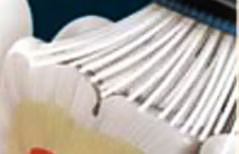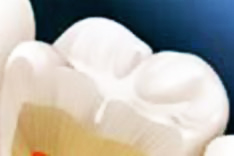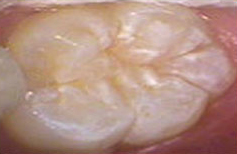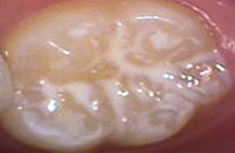 Fissure Sealants
Fissure Sealants
Most Cavities Occur On The Back Teeth.
The back teeth are full of grooves called pits and fissures. Food and bacteria often get trapped in these deep grooves and cause tooth decay. In fact, more than 75% of dental decay begins in these pit and fissure areas of the back teeth.
 |
 |
Brushes Can't Reach Groove |
Groove Sealed |
Unfortunately, not even a single tooth brush bristle can reach all the way into the depressions and grooves to remove food particles, bacteria and plaque. So no matter how often you brush your teeth, cavities may still occur in these areas.
How Do We Prevent Cavities In These Areas?
The best protection for the biting surfaces of your back teeth is a product called pit and fissure sealant.
What Are Sealants?
Sealants are thin, plastic coatings applied to the pits and fissures, which flows to the depth of the grooves sealing out decay causing bacteria.
Are Sealants Suitable For All Teeth?
No. Sealants are applied only to pit and fissure areas of specific teeth. Unfortunately, they cannot be applied to surfaces in between teeth where daily flossing is recommended to prevent decay.
When Is The Best Time To Place Sealants?
To prevent decay, the best time to place a sealant is just after the back tooth erupts and is clear of soft tissue. Though sealants are most often applied to children's teeth, many adults are now seeking the prevention benefit of sealants as well.
How Are Sealants Applied?
Applying sealants is a very simple, painless procedure. The tooth grooves are first cleaned and dried. A solution is applied to the chewing surface of the tooth to condition the enamel and help it bond more effectively to the sealant material. The tooth is thoroughly washed and dried. Then a bonding resin is placed on the etched surface, set by a special light, then the sealant material is applied and set by the same light. The procedure only takes a few minutes.
 |
 |
Before Sealants |
After Sealants |
Do Sealants Last?
Yes, in dental studies, a single sealant application has shown to last for 7 years or more. Research has shown that as long as a sealant remains in place and intact, the chewing surface is 100% protected from cavities. The longevity of sealants depends on factors like your chewing patterns, grinding habits and your diet. Occasionally we might need to replace or add a new layer of sealant material to keep the protective barrier strong and effective!
It is critical that sealants be checked routinely to make sure that they remain intact.
Why is Sealing a Tooth Better than Filling a Cavity?
Sealants help maintain sound teeth. Decay destroys the structure of the tooth. Each time a tooth is filled or a filling is replaced, additional tooth structure is lost.
Sealants save time, money and the need for restorative dental procedures. Sealants are a simple, pain free, cost effective treatment to prevent tooth decay in certain areas of the mouth.











